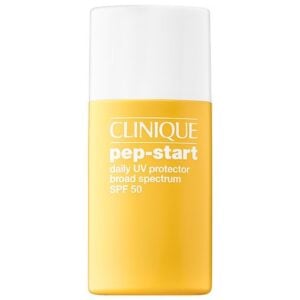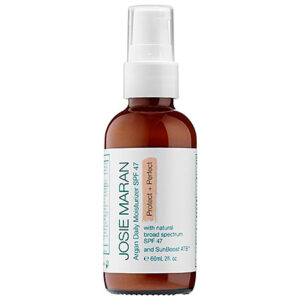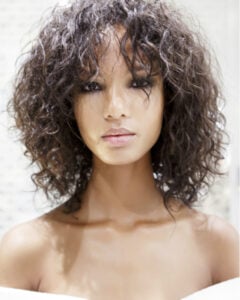At the heart of any good skincare routine is the practice of protecting the skin from the sun’s harmful ultraviolet rays (also known as UV rays). In fact, there are plenty of studies to demonstrate that diligent daily sunscreen application can slow or prevent the onset of wrinkles and sagging skin.
But not all sunscreen is good (or effective) sunscreen. If you don’t know the difference, then let us help you. In this guide, we’re breaking down how to pick a good sunscreen (and making some of our top recommendations).
UNDERSTANDING UV (ULTRAVIOLET)
The sun sends three types of UV (ultraviolet) radiation toward the earth’s surface and, by extension, your skin. These are UVA, UVB, and UVC. For the purposes of sunscreen, we’re just going to focus on UVA and UVB.
Though you might assume that all sunscreens protect against everything the sun throws our way, that’s actually a misconception. Many sunscreens actually only protect against UVB, and this raises major concerns. Here’s why:
The majority of UV rays that reach us – approximately 95% – are UVA. These have been coined “aging rays” because they penetrate deep into the dermis and play a big part in the premature aging of skin (such as fine lines, wrinkles, and hyperpigmentation). UVB rays, on the other hand, mainly affect the epidermis, which only includes the top layers of the skin. Although they do contribute to the signs of aging, they’re mostly associated with sunburn.
If you’re interested in learning more, explore our guide on the damage UV rays cause skin. In it, we cover the different types out there as well as best practices to abide by.
WHAT IS SPF?
SPF stands for Sun Protective Factor and it only relates to the level of protection a sunscreen provides against UVB rays. The SPF number on a sunscreen, therefore, is a ratio of the amount of UVB required to cause sunburn when the skin is protected with sunscreen divided by the amount of UVB required to cause a burn without sunscreen.
Theoretically, then, SPF 30 means your skin can be exposed to 30 times more UVB radiation compared to without sunscreen on.
SPF PROTECTION LEVELS
SPF labels in Australia, the EU, New Zealand, and the US are quite similar. An approximate guideline is provided below:
Low protection: SPF 6-10
Medium/moderate protection: SPF 15-25
High protection: SPF 30-50
Very high protection: SPF 50+
For preventative and anti-aging purposes, go with at least SPF 30 (or higher) for daily wear.
SPF LIMITATIONS
The amount of UVB radiation coming from the sun changes depending on different factors, such as time of day, geographic location, season, and weather conditions. That means that you can’t count on being able to stay out 10 times longer in the sun without burning. You always have to plan the level of SPF you’re wearing according to where you are and the conditions you’re facing.
Another important note about SPF ratings is that they don’t actually mean much beyond a certain point. SPF 15 sunscreen is estimated to block 93% of UVB radiation, SPF 30 is estimated to block 97%, and SPF 50 is estimated to block 98%. But once you go above SPF 50, the increase in protection against UVB radiation is minimal. In fact, in the European Union and Australia, regulations have been updated and no labels can claim more than 50 SPF.
SPF ALTERNATIVES & UVA PROTECTION
Now that you’re aware of the fact that SPF only refers to protection against UVB rays, you’re probably wondering: what about UVA? How do we protect against those “aging rays” (especially considering they make up a large majority of the rays that reach us)?
Until recently, nobody was really looking at the harmful effects of UVA and, as a result, there’s no standardized method for measuring UVA protection. But here are some labels and claims you may come across:
UVA Protection Factor (UVA-PF) is a ratio that works kind of like SPF. For example, a UVA-PF of 30 would mean that the skin can be exposed to 30 times more UVA with the sunscreen than without it. This system is generally used in Europe and it’s based on human testing of Persistent Pigment Darkening (PPD).
PPD is also a ratio, except this ratio tells us how much UV the skin can be exposed to before it develops a long-lasting tan with the sunscreen versus without. They use this test because tans are mostly caused by UVA. A PPD of 10, for example, means that a person can be exposed to 10 times the amount of UVA with the sunscreen on than they could without that protection.
Protection Grade of UVA (PA) is based on PPD, but it’s typically used in Asia.
PA+ : corresponds to a PPD protection between 2 and 4
PA++ : corresponds to PPD protection between 4 and 8
PA+++ : corresponds to PPD protection between 8 and 16
PA++++ : corresponds to PPD protection of more than 16.
The higher the PA or PPD rating, the higher the protection offered.
The UVA Circle symbol tells you that the UVA protection of that sunscreen is at least a third of the SPF. For example, if a sunscreen with the UVA Circle symbol has an SPF 30, you can expect a UVA 10 or higher. This symbol doesn’t tell you the exact UVA protection, just the minimum you might expect.
WHAT IS BROAD-SPECTRUM?
The term broad-spectrum is used to identify sunscreens that offer protection against both UVA and UVB rays. This might get complicated, so let’s keep it as simple as possible.
UV radiation is measured in wavelengths which are in turn measured in nanometers. The UV spectrum ranges from 290 nanometers to 400 nanometers, with UVA between 315 and 400 nm and UVB between 280 and 315 nm.
Broad-spectrum sunscreen uses critical wavelengths to determine the level of protection across the UV spectrum. In order to be considered a broad-spectrum in the EU and US, the sunscreen must have a critical wavelength of 370 nm or more, which means that 10% of the protection offered by the sunscreen is for wavelengths above 370 nm. That covers the breadth of UVB rays plus UVA rays (although, how much exactly is TBD).
We highly recommend looking for a broad-spectrum sunscreen for preventative anti-aging. Although label requirements can vary, they typically have to meet that minimum to be called a broad-spectrum sunscreen, so you know you’re getting a high amount of protection against both kinds of harmful UV radiation.
PHYSICAL SUNSCREEN VERSUS CHEMICAL SUNSCREEN
PHYSICAL SUNSCREENS
Physical sunscreens sit on the surface of the skin and work by deflecting or scattering UV rays.
The two most popular physical sunscreens are zinc oxide and titanium dioxide. These natural minerals are ground into a fine powder and take a long time to break down with sun exposure.
Zinc oxide is able to protect the skin against the entire spectrum of UVB and UVA from 290-400 nm. In the past, it tended to leave a white cast on the skin and make people look like they were wearing bad makeup, but recent technological advances (i.e. micronizing), have minimized this unsightly effect.
Titanium dioxide protects against UVB rays but not the full spectrum of UVA rays. Another thing to note about titanium dioxide is that it may cause breakouts for those with sensitive skin.
A Note on Micorionized Ingredients
As mentioned above, the process of micronizing ingredients like Titanium Dioxide and Zinc Oxide provides cosmetic benefits like making a sunscreen easier to spread and minimizing the formula’s white cast. But experts are torn on the benefits versus the risks.
Some experts fear that micronized ingredients pose a higher risk of ingredients being absorbed into the body’s tissues. Truth be told, the absorption rate does increase, but multiple studies indicate that the levels are minimal. So, in this case, we believe that the benefits outweigh the risks.
CHEMICAL SUNSCREENS
Chemical sunscreen work by absorbing UV rays. They often get a bad reputation for being unstable and rapidly breaking down when exposed to the sun, which can trigger the formation of free radicals. But, from what we can tell, those risks depend on the type of chemical sunscreen.
Below are some of the popular chemical-based sunscreen agents available in North America:
Avobenzone is relatively non-irritating and protects against an entire range of UVA light from 310-400 nm. It does break down with sun exposure when used alone so it needs a photo stabilizer such as Tinsorb S and M (see below for more information).
Mexoryl SX and XL protect against both UVA and UVB rays from 290-400 nm and don’t degrade or lose effectiveness with sun exposure. They are minimally absorbed into the body through the skin, but the downside is that these ingredients are known to be skin irritants.
Tinosorb S and M (Ecamsule) protect against UVA and UVB rays from 280-400 nm, rarely cause skin irritation, and don’t degrade or lose effectiveness with sun exposure. They’re actually a hybrid chemical and physical sunscreen since they both absorb and scatter UV rays.
Why You Might Consider Avoiding Chemical Sunscreens
Chemical sunscreens are excellent at providing protection against the range of UV, but the ones that are widely available in North America require support from a combination of chemical protection agents to prevent degradation from sun exposure and to ensure the formula’s stability. Studies are unclear as to the potential for skin damage and other health implications when these chemical agents release free radicals.
RECOMMEND PRODUCTS
Here are some physical sunscreens we recommend that provide a powerful level of protection against the damage caused by UV rays:
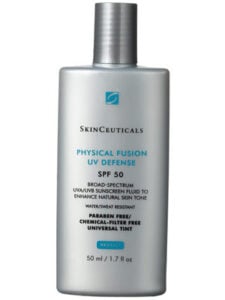 Skinceuticals Physical Fusion Defense ($26.54)
Skinceuticals Physical Fusion Defense ($26.54)
Best For: Normal to Combination & Sensitive Skin
The highly-rated fluid SPF 50 sunscreen is lightweight, provides hydration, and still works great under makeup. UV protection is provided by the combination of 5% Zinc Oxide, 6% Titanium Dioxide and has a tinted formula to help hide white cast. The sunscreen is also fragrance-free, feels great on the skin, and dries with a semi-matte finish to avoid an overly dewy situation.
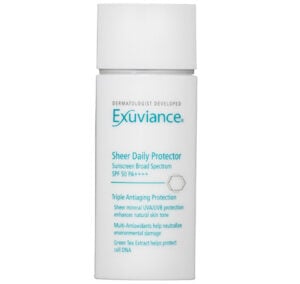 Exuviance by Neostrata Sheer Daily Protector SPF ($37.45)
Exuviance by Neostrata Sheer Daily Protector SPF ($37.45)
Best For: Normal to Combination Skin
Gentle and fragrance-free with the maximum recommended of SPF 50 and the highest PA level, this tinted fluid sunscreen is another great choice for preventing the harmful effects of the sun. In addition to containing both 6.0% Zinc Oxide and 7% Titanium Dioxide, it contains antioxidants including Vitamin E to boost the formula. Note that there are some thickening agents in this product that may make it feel a little heavy.
Clinique Pep Start Daily UV Protector ($19.50)
Best For: Normal, Combination & Sensitive Skin
Clinique’s broad-spectrum sunscreen has an SPF of 50 and is mineral-based, made from a combination of 4% Zinc Oxide as well as 6.3% Titanium Dioxide. Not only is the formula lightweight but the peach tint blends well with the skin and dries in a matte finish. Other product benefits include that it is fragrance-free and doesn’t have parabens, sulfates, or phthalates.
bareMinerals Mineral Shield Broad Spectrum SPF 50 Daily Prep Lotion ($30)
Best For: Normal To Combination Skin
bareMinerals Prep Step, mineral-based, broad-spectrum sunscreen helps to hydrate as it protects. Although tinted, the formula dries with a nearly invisible white cast (unless you’re very fair) as it has an extremely high level (23.8%) of Zinc Oxide, combined with 4.1% Titanium Dioxide in order to provide a strong barrier against UV rays when used correctly. The light-weight lotion works well as a primer under makeup and is both fragrance as well as oil-free.
Md Solar Sciences Mineral Creme Broad Spectrum SPF 50 ($30)
Best For: Normal to Oily Skin
Md Solar Sciences 50% SPF cream packs in multiple skin-beneficial ingredients like Green Tea and Pomegranate Extract that when combined with the 2% Titanium Dioxide as well as the 17% Zinc Oxide provides a high level of protection from the sun’s UV rays. Although the formula is tinted and dries sheer, the white cast may be visible on darker skin tones.
Josie Maran Argan Daily Moisturizer SPF 47 Protect + Perfect ($30.50)
Best For: Normal to Dry Skin (not prone to breakouts)
The winning combination of rich Argan Oil and hydrating Aloe Vera has this broad-spectrum sunscreen (9.4% Zinc Oxide & 5.9% Titanium Dioxide) packing an intense moisturizing boost. Other notable ingredients we love include Green Tea, the free radical fighting antioxidant known for its anti-inflammatory properties, and the healing Vitamin E. Not only is the formulation blendable with a tint to mask the white cast mineral sunscreens often have but it also works great under makeup. For those of you that fall on the lighter side of the skin spectrum, the non-tinted version might be more of a suitable match.
Murad City Skin Age Defense Broad Spectrum Sunscreen ($65)
Best For: Combination, Dry & Sensitive Skin
Murad’s 100% mineral-based broad-spectrum sunscreen combines 10% zinc oxide with 2.7% Titanium Dioxide to provide SPF 50 (PA++++) protection from the sun’s rays. Although on the pricier side, the highly blendable formula avoids leaving a white cast on most skin-tones as well as provides anti-aging support through ingredients like Vitamin C (Ascorbic Acid). Last but certainly not least it should be noted that the sunscreen is free of parabens and sulfates.
First Aid Beauty’s Ultra Repair Pure Mineral Sunscreen Moisturizer ($30)
Best For: Normal To Dry Skin
Through the replenishing power of Shea Butter, Ceramides, and Triglycerides along with 4.6% Zinc Oxide as well as 6.3% Titanium Oxide, FAB’s broad-spectrum sunscreen help to boost skins’ hydration levels all while protecting it from the harmful, aging effects of the sun. The whipped-cream -like texture certainly leaves skin supple but as the formula is untinted it may work best for those on the fairer end of the color spectrum. Although, when well-blended the sunscreen leaves minimal to no white cast. Other notable ingredients to look out for include the antioxidants Licorice Root, Feverfew, and White Tea Extracts that help to boost the rejuvenating benefits of the moisturizer.
KEY UV PROTECTION BOOSTERS
Formulating sunscreens with antioxidants has become increasingly popular over the last few years – and for good reason. Certain antioxidants can help boost the skin’s natural defence system against UV radiation. Meaning that, instead of having to heal damage, you can actually prevent it from ever happening.
These are some of the best antioxidants to look for in your sunscreen formulas.
VITAMIN C
UV rays activate the production of melanin, which is a substance in the body that’s responsible for hair, eye, and skin pigmentation. Melanin is a huge cause of hyperpigmentation and dark spots, but Vitamin C inhibits melanin synthesis, stopping these skin concerns in their tracks. Of course, as an antioxidant, it also fights the free radical damage caused by the sun’s UV rays.
VITAMIN E
UV light and exposure to the sun reduce the natural amount of Vitamin E we have in our body, so supplementing those levels via sunscreen is an excellent way to combat that effect. This vitamin also absorbs energy from UV light and plays a vital role in photoprotection and preventing free radical damage. What makes it extra special, though, is the fact that it’s anti-inflammatory – so it can help treat redness and inflammation that results from sun exposure or sunburn.
Studies show that the combination of Vitamins C and E provides advanced protection from UV damage, especially when they’re further combined with a broad-spectrum sunscreen. We like to apply these vitamins via serums prior to applying sunscreen. Learn more about these serums in our guide to The Best Vitamin C Serums.
GREEN TEA
The main antioxidant in green tea is catechin, which not only mitigates the damaging effects of UV radiation but also blocks collagen degeneration. Collagen is what keeps the skin smooth and taught, but it breaks down with sun exposure as well as with age. Anything that stops this process is a-ok in our books, especially when it’s totally natural, too.
THINGS TO NOTE
Below are some general guidelines to note before using sunscreen:
- Chemical sunscreens need to be absorbed into the skin to work, so they should be applied 20 to 30 minutes before sun exposure.
- Stronger physical sunscreens don’t come off easily with a water-based facial cleanser. They often need to be removed with a good oil-based cleanser.
- Apply your sunscreen after your moisturizer and serum but before your makeup application.
- Avoid sunscreens that have high levels of alcohols like SD Alcohol, Ethanol, Denatured, Isopropyl, Methanol or Ethyl Alcohol. These ingredients are linked to damaging the skin’s barrier.
- While all sunscreen breaks down with UV exposure, physical ones are supposed to take longer to do so. To maintain maximum UV protection, experts recommend reapplying sunscreen every 2 hours. If it’s an especially humid, sweaty day or you’re out swimming or exercising, it may be a good idea to reapply more frequently,
GUIDELINES FOR APPLICATION
Not sure how much sunscreen you need? Here are some guidelines for the most important body parts:
- Face: 1/4 teaspoon of sunscreen
- Neck 1/4 teaspoon of sunscreen (front and back)
- Chest: 1 teaspoon of sunscreen
- Back: 1 teaspoon of sunscreen
- Arms: 1/2 teaspoon of sunscreen per arm
- Legs: 1 teaspoon of sunscreen per leg
FINAL THOUGHTS
Buying an effective sunscreen may seem complicated (and pricey) but this is truly one of the most essential aspects of your skincare routine, so it’s worth all the time and effort. If you’re not sure, try one of our recommendations – we spend a lot of time researching and testing them so you don’t have to!


